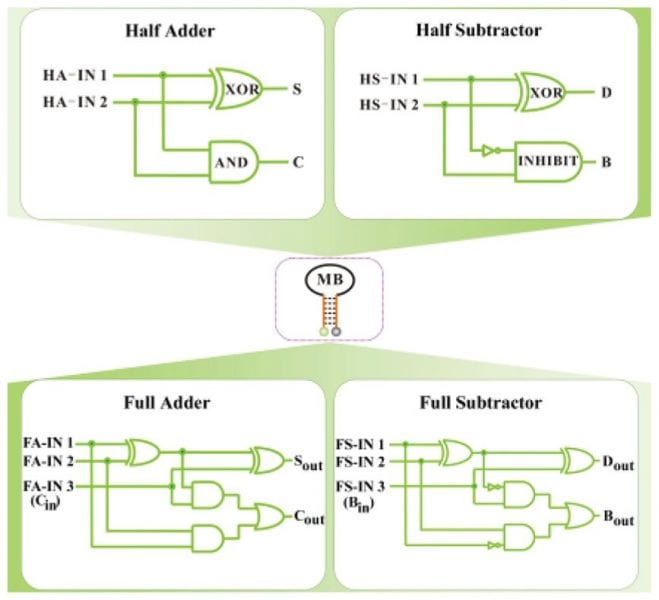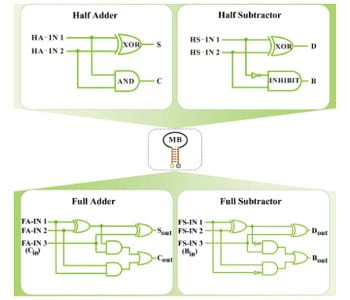Looking through the history of humanity with respect to count and computing, electronic computers appeared just about 60 years ago,  exhibiting unprecedented performance and thus revolutionizing computation. However, electronic computers mark neither the beginning nor the end of the history of computation due to its limits. Molecular computing is a fascinating area of research that involves molecular-level data processing and has projected chemistry onto the forefront of information and technology. DNA is considered an outstanding engineering material for addressing the central problems of molecular computing by virtue of its inherent merits, including easy synthesis, structural simplicity, high flexibility, sufficient sequence design space, and predictable molecular behavior. All of these merits provide an opportunity to construct molecular-level complex and integrated logic circuits, which are critical to processors.
exhibiting unprecedented performance and thus revolutionizing computation. However, electronic computers mark neither the beginning nor the end of the history of computation due to its limits. Molecular computing is a fascinating area of research that involves molecular-level data processing and has projected chemistry onto the forefront of information and technology. DNA is considered an outstanding engineering material for addressing the central problems of molecular computing by virtue of its inherent merits, including easy synthesis, structural simplicity, high flexibility, sufficient sequence design space, and predictable molecular behavior. All of these merits provide an opportunity to construct molecular-level complex and integrated logic circuits, which are critical to processors.
To make further advancements in molecular computation, Prof. Erkang Wang and co-workers (Changchun Institute of Applied Chemistry, China) constructed a series of advanced logic circuits in proof-of-principle experiments based on a single and universal molecular beacon (MB) platform to execute multiple arithmetic functions, including half adder, half subtractor, full adder, full subtractor, and digital comparator. Their strategy might also be used to design much more complex DNA logic circuits based on a simple DNA platform with limited sequence.
The demonstrated DNA networks are endowed with excellent biocompatibility compared with those based on complex synthetic organic molecules. Another advantage over some previous networks lies in its multiple signal generation which occurs in parallel while sharing the same DNA-based platform, not by a simple combination of independent logic gates to form desired circuits based on different platforms. All of the complex logic circuits share the same DNA-based platform and a constant threshold setpoint, eliminating the need to use enzymes or DNAzymes to increase specificity.
The versatility and power of the demonstrated DNA computing indicate promising applications in solving complex combinatorial problems on the molecular level. It is also expected that the DNA-based molecular computing platform will find great potential in disease diagnosis and therapy due to its biocompatibility. Read the whole research article now in the latest issue of Advanced Science.
Advanced Science is a new journal from the team behind Advanced Materials, Advanced Functional Materials, and Small. The journal is fully Open Access and is free to read now at www.advancedscience.com.

















